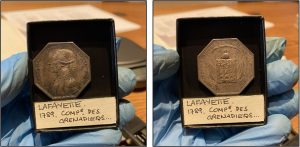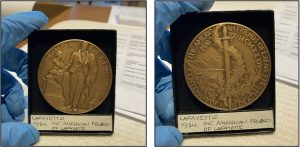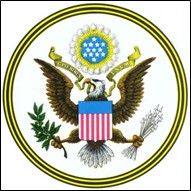By Evan McDonagh, Library Assistant
Visitors to the MHS will not be surprised to learn that the Society holds an extensive records collection on early American history. On paper and film alone, the Society houses more than fourteen million pages of manuscripts, approximately 120,000 images, more than 10,000 broadsides, and over 2,500 maps among a plethora of books and other items.[1] However, the MHS also possesses a wide range of unconventional American artifacts, many of which receive less visibility than the more prominent paper records. The Society’s numismatic holdings provide one such example.
As defined by Meriam-Webster dictionary, numismatics refers to “the study or collection of coins, tokens, and paper money and sometimes related objects (such as medals).” The Society holds a plethora of coins, tokens, and medals, with medals’ being of particular interest.
Beginning shortly after the end of the Revolutionary War, the production of medals and tokens bearing the likenesses of prominent heroes and political figures cemented and reinforced the developing American mythos. Likewise, collecting these special coins, tokens, and medals became a means of demonstrating individual patriotism and of flexing one’s status and means.

Patriotic artisans found a popular subject in the Revolutionary War hero Gilbert du Motier, Marquis de Lafayette. Born on 6 September 1757 in Chavaniac, France as the orphaned son of a French aristocratic family, Lafayette traveled to the rebelling American colonies in July 1777 to obtain glory as a revolutionary fighter. Despite his lack of experience, the young soldier quickly won the friendship of George Washington. Lafayette earned distinction and fame for his actions at the Battle of the Brandywine in 1777, Barren Hill in 1778, and his successful campaigns against British commanders Benedict Arnold and Lord Charles Cornwallis in 1781.
By the war’s end, Lafayette had attained nationwide fame, so much so that several states named him an honorary citizen during a 1784 visit. Lafayette’s youth and reputation marked him as an ideal figurehead and symbol for Revolutionary War medals and tokens.[2]

In the present day, the MHS has the good fortune to hold a number of Lafayette medals dating from the Revolutionary War to the late 19th century. Many of these medals come from the collection of William Sumner Appleton, Sr., a wealthy Boston resident in the late 19th century. Appleton specialized in the preservation of historic homes, but American coins and medals ranked high among his other interests. Upon Appleton’s death, his estate split up his numismatic collection, and though it sold a majority of the coins, the “Americana” part of the collection – U.S. colonial and federal coins and U.S. and personal medals – found its way to the MHS in 1905. Other Lafayette medals entered the collection in the following decades.

The Lafayette medal collection showcases a method by which Americans have left their history and mythos to the future. Even during the 19th and 20th centuries, the production of new Lafayette medals saw the celebration of the general and of American patriotism go hand in hand. This 1934 Lafayette medal (above), produced by the American Friends of Lafayette to celebrate the centenary of the general’s death, demonstrates this dichotomy. Lafayette walks past a pillar labeled “America’s Adopted Son,” a reflection of Lafayette’s French roots and the mythos of the great American melting pot. Meanwhile, the depiction of the sword and olive branch, of war and peace, reflects the symbology present on the Great Seal of the United States.[3]

The Lafayette medals serve as a portable, collectible reminder of the American experiment. Their inclusion in the Society’s collection alongside other numismatic items and artifacts speak to the plethora of ways in which Americans have chosen to remember and to commemorate their history.
[1] Massachusetts Historical Society. “Our Collections.” Accessed July 27, 2022. https://www.masshist.org/collections/our-collections.
[2] Leepson, Marc. “Marquis de Lafayette.” Britannica. Accessed July 27, 2022. https://www.britannica.com/biography/Marquis-de-Lafayette.
[3] National Museum of American Diplomacy. “The Great Seal.” Accessed July 29, 2022. https://diplomacy.state.gov/exhibits/explore-online-exhibits/the-great-seal/.

